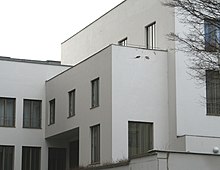Margaret Stonborough-Wittgenstein
This article needs additional citations for verification. (March 2009) |

Margarethe "Gretl" Stonborough-Wittgenstein (September 19, 1882, Neuwaldegg – September 27, 1958, Vienna), of the prominent and wealthy Viennese Wittgenstein family, was a sister of the philosopher Ludwig Wittgenstein and the pianist Paul Wittgenstein.[1] She was the subject of a famous 1905 portrait made for her wedding by the artist Gustav Klimt (Stonborough-Wittgenstein and other members of the Wittgenstein family were among Klimt's most important patrons), which was sold in 1960 by her son Thomas and may now be seen in the Neue Pinakothek gallery in Munich.[2]
On 7 January, 1905, she married a wealthy American, Jerome Stonborough (1873 -June 1938, suicide). Of German Jewish ancestry and born Jerome Herman Steinberger, he had had his name changed to Stonborough in 1900. He was also an art collector. They were close friends with Hermann Rothe, Margaret was the godmother of his daughter Margarethe. The couple had two sons and divorced in 1923.
- Dr. Thomas Humphrey Stonborough (1906-?). His Swiss friend Marguerite Respinger (1904-2000), whom he had met when he was studying in Cambridge and had invited to Vienna, was briefly (1926-1931) the only known female interest of Ludwig Wittgenstein. In 1939, Thomas Stonborough married Elizabeth Churchill, but they soon divorced (she remarried Washington Evening Star columnist Constantine Brown, and became a journalist and anti-communist activist under the name of Elizabeth Churchill Brown).
- Major John Jerome Stonborough (11 June 1912, Vienna - 29 April 2002, Ferndown, Dorset). Although a US citizen, he served in the Canadian army during Second World War as an intelligence officer and interpreter. He married the daughter of a distinguished Northumberland family, Veronica Morrison-Bell (daughter of Sir Claude William Hedley Morrison-Bell, 2nd Baronet), and after the war lived between Britain and Austria.
After the First World War, Stonborough-Wittgenstein was appointed by the American Relief Administrator Herbert Hoover (later president of the United States) as special representative of the American Relief Program for Austria. When working in juvenile prisons as a psychotherapy adviser, she came into contact with Sigmund Freud and was analyzed by him during two years. They remained in contact until Freud's death.[3]

In 1926, she commissioned her brother Ludwig and the architect Paul Engelmann to design and build Haus Wittgenstein in Vienna. Sold by her son Thomas in 1968, this noted building still stands today, and now houses the Bulgarian Cultural Institute. In 1940, she emigrated to the USA, but returned to Austria after the war and obtained restitution of part of her wealth which had been confiscated by the Nazis.
Notes
- ^ Bartley, William Warren. Wittgenstein. Open Court, 1994, p. 34ff, first published 1973.
- ^ Edmonds, David; Eidinow, John (2002). Wittgenstein's Poker: The Story of A Ten Minute Argument Between Two Great Philosophers. New York, NY: Ecco / Harper Collins Publishers. p. 83. ISBN 978-0-06-093664-8.
{{cite book}}: CS1 maint: multiple names: authors list (link) - ^ Edmonds, David; Eidinow, John (2002). Wittgenstein's Poker: The Story of A Ten Minute Argument Between Two Great Philosophers. New York, NY: Ecco / Harper Collins Publishers. pp. 76–77. ISBN 978-0-06-093664-8.
{{cite book}}: CS1 maint: multiple names: authors list (link)
